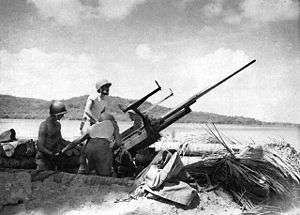37 mm Gun M1
| 37mm Gun M1A2 on Carriage M3 | |
|---|---|
|
37mm antiaircraft gun in the Solomon Islands. | |
| Type | Anti-aircraft autocannon |
| Place of origin | USA |
| Service history | |
| Used by | USA |
| Wars | World War II |
| Production history | |
| Designer | John M. Browning and the Colt company |
| Produced | 1939–? |
| Number built | 7,278 |
| Specifications | |
| Barrel length | bore: 2 m (6.56 ft) / 54 calibers |
|
| |
| Shell | 37×223mmSR |
| Caliber | 37 mm (1.45 in) |
| Breech | vertical block |
| Carriage | four-wheeled trailer |
| Elevation | -5° to + 90° |
| Traverse | 360° |
| Rate of fire | 120 rounds per minute |
| Muzzle velocity | 792 m/s (2,598 ft/s) |
| Effective firing range | 3,200 m (3,499 yds) |
| Maximum firing range | 8,275 m (9,049 yds) |
The 37mm Gun M1 was an anti-aircraft autocannon developed in the United States. It was used by the US Army in World War II.
In addition to the towed variant, the gun was mounted, with two M2 machine guns, on the M2/M3 half-track, resulting in the T28/T28E1/M15/M15A1 series of multiple gun motor carriages.
In early World War II, each Army Anti-Aircraft Artillery (AAA) Auto-Weapons battalion was authorized a total of thirty-two 37 mm guns in its four firing batteries, plus other weapons.[1]
During World War II the 37 mm gun M1 was deployed in coast defense Anti-Motor Torpedo Boat Batteries (AMTB) alongside 90 mm guns, usually four 90 mm and two 37 mm guns per battery. Some AMTB batteries consisted of four 37 mm guns, but most sources have little information on these batteries. In the later part of the war the 37 mm gun was typically replaced by the 40 mm Bofors gun M1.[2]
Components
Two gun units were coupled to the M5 gun director using the M1 remote control system. The system was powered by the M5 generating unit. If the remote system was inoperative the M5 sighting system was used.
Ammunition
The M1 utilized fixed ammunition. Projectiles were fitted with a 37×223mmSR cartridge case.
| Available ammunition | |||||
| Type | Model | Weight (round/projectile) | Filler | Muzzle velocity | Range horizontal/vertical[3] |
| APC-T | APC-T M59A1 Shot | 1.44/0.87 kg (3.17/1.91 lbs) |
- | 625 m/s (2,050 ft/s) |
5,290/3,660 m (17,355/12,007 ft) |
| HE-T | HE-T SD M54 Shell | 1.21/0.61 kg (2.66/1.34 lbs) |
792 m/s (2,598 ft/s) |
8,275/5,760 m (27,149/18,897 ft) | |
| Armor penetration table | ||||
| Ammunition / Distance | 457 m (499 yds) |
914 m (999 yds) |
1,371 m (1,499 yds) |
1,828 m (1,999 yds) |
| APC-T M59A1 Shot (homogeneous armor, meet angle 30°) | 23 mm (.90 in) |
18 mm (.70 in) |
15 mm (.59 in) |
13 mm (.51 in) |
| APC-T M59A1 Shot (face-hardened armor, meet angle 30°) | 25 mm (.98 in) |
18 mm (.70 in) |
15 mm (.59 in) |
13 mm (.51 in) |
| Different methods of armor penetration measurement were used in different countries / periods. Therefore, direct comparison is often impossible. | ||||
Variants
- The 37 mm M9 autocannon was a derivative of the M1A2 anti-aircraft gun. It had a 74-inch barrel, weighed 405 pounds (the barrel alone weighing 120 pounds), had a muzzle velocity of 3,000 feet per second, and had a rate of fire of 150 rounds per minute. It was used on PT boats around 1944 in the Pacific theater during World War II, replacing the M4 autocannon.
See also
Notes
- ↑ 385th AAA Auto-Weapons Battalion website
- ↑ McGovern and Smith, p. 43
- ↑ Shell destroying tracer limited the range to about 3,200 m.
References
- Hogg, Ian. Twentieth-Century Artillery. New York: Barnes & Noble Books, 2000. ISBN 0-7607-1994-2 Pg.106
- Hogg, Ian V. (1998). Allied Artillery of World War Two. Ramsbury, Marlborough, Wiltshire: Crowood Press. ISBN 1-86126-165-9.
- Hunnicutt, R. P. (2001). Half-Track: A History of American Semi-Tracked Vehicles. Novato, CA: Presidio Press. ISBN 0-89141-742-7.
- McGovern, Terence; Smith, B. W. (2006). American Coastal Defenses 1885-1950. New York: Osprey Publishing. ISBN 1-84176-922-3.
- TM 9-2300 standard artillery and fire control material. dated 1944
- TM 9-235
- TM 9-1235
- SNL A-29
External links
| Wikimedia Commons has media related to 37mm Gun M1. |
- "US Army Gets A New Antiaircraft Gun", September 1940, Popular Science
- FM 4-112 Coast Artillery Field Manual: Antiaircraft Artillery gunnery, Fire Control, Position Finding, and Horizontal Fire, Antiaircraft Automatic Weapons (Case I Firing)
- History of the Americanization of the Bofors 40mm Automatic Antiaircraft Gun—some references to the 37mm
- 37mm Antiaircraft Automatic Gun—Antiaircraft.org
